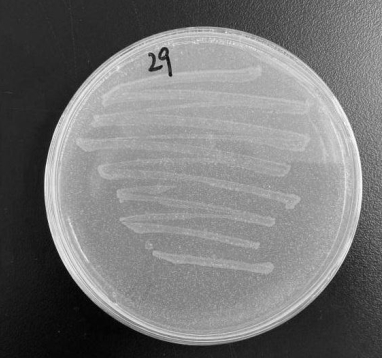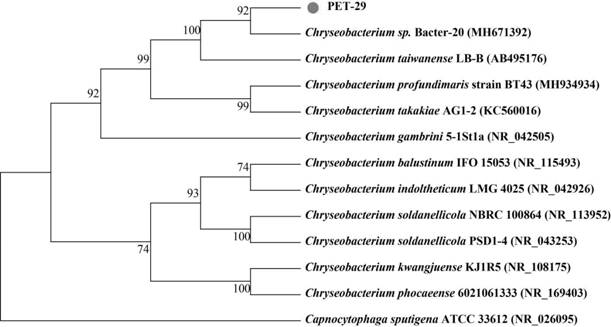Chryseobacterium sp., fungicide containing Chryseobacterium sp., application of Chryseobacterium sp. And fungicide and method for degrading plastic
A technology of Chryseobacterium aureus and plastic degradation, applied in the field of microorganisms, can solve the problems of harsh degradation conditions, less biodegradation of plastic products, and high cost, and achieve the effects of low production cost, convenient operation, and low cost
- Summary
- Abstract
- Description
- Claims
- Application Information
AI Technical Summary
Problems solved by technology
Method used
Image
Examples
Embodiment 1
[0063] (1) Isolation of strains
[0064] Take the waste from a landfill in Nanjing as the sample to be separated for separation and screening: Weigh 1g of the collected landfill waste sample and place it in 100mL containing diethyl terephthalate (polyethylene terephthalate). The structural analog of alcohol ester, the concentration is 2g / L) in the inorganic salt liquid medium (diethyl terephthalate is the only carbon source), in a constant temperature shaking incubator at a temperature of 30 ° C and a speed of 150 rpm The next 4-6 days of shaking culture is one round. After five rounds of shaking culture, take the culture solution of the fifth round to prepare a bacterial suspension, and dilute the bacterial suspension to 10 by volume gradient. -6 , 10 -7 , 10 -8 times the diluted bacterial suspension; draw 0.1 mL gradient of the diluted bacterial suspension and spread it on the inorganic salt solid medium containing high-temperature sterilized polyethylene terephthalate par...
Embodiment 2
[0075] (1) The Bacillus aureus PET-29 obtained in Example 1 was cultured in a LB liquid medium at a temperature of 30° C. and a rotational speed of 150 rpm to a logarithmic phase as a first-class seed solution, and the first-class seed solution was divided by volume. 1.5% of the inoculum was inoculated into the LB liquid medium, and the temperature was 30 ° C and the rotation speed was 150 rpm and the shaking culture was carried out to logarithmic phase to obtain secondary seed liquid;
[0076] (2) The secondary seed solution was inoculated into 50 mL of LB liquid medium at a volume ratio of 1% at a temperature of 30 °C, a rotation speed of 150 rpm, and pH of 5.5, 6.0, 6.5, 7.0, 7.5, and 8.0, respectively. Cultivated for 60h under conditions, and sampled at 6h, 12h, 24h, 36h, 48h, and 60h; dilute the sample of the fermentation broth by 10 times, and detect the OD 600 , measured the growth curve of Bacillus aureus PET-29, the results are as follows Figure 4 shown.
[0077] f...
Embodiment 3
[0079] (1) The Bacillus aureus PET-29 obtained in Example 1 was cultured in a LB liquid medium at a temperature of 30° C. and a rotational speed of 150 rpm to a logarithmic phase as a first-class seed solution, and the first-class seed solution was divided by volume. 1.5% of the inoculum was inoculated into the LB liquid medium, and the temperature was 30 ° C and the rotation speed was 150 rpm and the shaking culture was carried out to logarithmic phase to obtain secondary seed liquid;
[0080] (2) The secondary seed solution was inoculated into 50 mL of LB liquid medium at a volume ratio of 1%, at a temperature of 20 °C, 30 °C, 37 °C, and 45 °C, a rotation speed of 150 rpm, and a pH of 6. Culture for 60h, take samples at 6h, 12h, 24h, 36h, 48h, and 60h; dilute the sample of the fermentation broth by 10 times, and detect OD 600 , measured the growth curve of Bacillus aureus PET-29, the results are as follows Figure 5 shown.
[0081] from Figure 5 It can be seen that the g...
PUM
 Login to View More
Login to View More Abstract
Description
Claims
Application Information
 Login to View More
Login to View More - R&D
- Intellectual Property
- Life Sciences
- Materials
- Tech Scout
- Unparalleled Data Quality
- Higher Quality Content
- 60% Fewer Hallucinations
Browse by: Latest US Patents, China's latest patents, Technical Efficacy Thesaurus, Application Domain, Technology Topic, Popular Technical Reports.
© 2025 PatSnap. All rights reserved.Legal|Privacy policy|Modern Slavery Act Transparency Statement|Sitemap|About US| Contact US: help@patsnap.com



